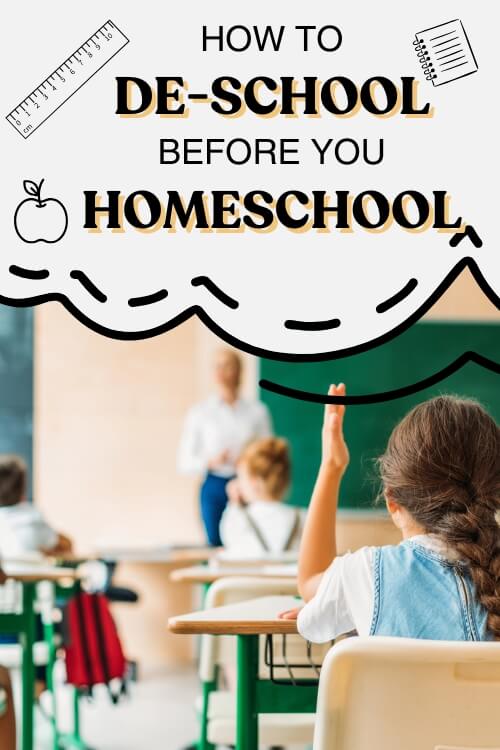Why You MUST De-School Before You Homeschool (and How to Do It Without Losing Your Mind)
So, you’ve decided to homeschool—woohoo! You’re gearing up, browsing curriculum, and maybe even setting up a little learning space. But before you dive in, there’s something absolutely crucial you need to do first: de-school.
Wait, what? Another step? I know, I know. You’re ready to get started. But trust me on this, de-schooling is the secret sauce to a smoother, more successful homeschooling journey.

What Is De-Schooling (and Why Should You Care)?
De-schooling is the process of unlearning the traditional school mindset, for both you and your child. If your child has been in a traditional school setting, they’re used to bells, rigid schedules, worksheets, and being told when they can eat, move, and even use the bathroom. And if you went to school yourself (which most of us did!), you probably have some deep-seated ideas about what learning should look like.
Here’s the thing: homeschooling is different. And if you try to recreate a classroom at home without first shedding those old-school habits and expectations, you’ll end up frustrated, burnt out, and wondering why things aren’t working.
Here are some signs you and your child need to de-school:
- Your child is resistant to learning at home or sees schoolwork as a chore.
- You feel the urge to structure every moment of the day.
- There’s tension and stress whenever you mention homeschooling.
- You worry that if your child isn’t constantly doing worksheets, they aren’t learning.
Sound familiar? Then it’s time to embrace de-schooling!
How Long Should You De-School?
It’s more about mindset than a strict timeline and each kid will be different. Some kids (and moms!) take longer to unwind, and that’s okay. The key is to let go of traditional school expectations and embrace a new, more natural rhythm of learning.
21 Creative (and Fun!) Ways to De-School
De-schooling isn’t just about taking a break from formal lessons. It’s about rediscovering the joy of learning in a low-pressure, curiosity-driven way. Here are 21 fun and meaningful ways to de-school:
- Read for Pleasure – No book reports, no assignments, just good books for the joy of reading.
- Get Outside – Take nature walks, explore parks, or just let the kids play freely outside.
- Follow Interests – Does your child love dinosaurs? Let them dive into books, documentaries, or even a museum visit without making it “school.”
- Cook Together – Math, science, and life skills all wrapped up in a fun, delicious activity.
- Watch Educational Shows & Documentaries – Learning happens through conversation and exposure, not just textbooks.
- Visit Museums & Zoos – Go without an agenda—just explore and enjoy.
- Encourage Creativity – Painting, music, building with LEGO, storytelling—whatever sparks joy.
- Let Them Be Bored – Yes, really! Boredom fuels creativity and problem-solving skills.
- Ease Into Routine Changes – Slowly adjust wake-up times, meal times, and daily structure so that learning can happen naturally.
- Talk About Their Feelings – Ask your child how they feel about leaving school, learning at home, and what excites (or worries) them.
- Play Board Games – Strategy, math, and critical thinking in disguise.
- Start a Nature Journal – Observe and record what you see outside.
- Go on a “Yes Day” Adventure – Let your child plan a day of activities.
- Have a Family Movie Day – Watch classic films and discuss themes.
- Go Camping (Even Indoors!) – Set up a tent and tell stories.
- Take a Road Trip to a Nearby Town – Explore local history and culture.
- Start a Family Book Club – Read and discuss books together.
- Shadow a Parent’s Work for a Day – Real-world learning in action.
- Volunteer Together – Help at an animal shelter or food bank.
- Listen to Audiobooks Together – A different way to experience stories.
- Just Talk – Share dreams, laugh, and connect—learning happens in conversation too!
Trust the Process (Even When It Feels Uncomfortable)
If de-schooling feels strange or unproductive at first, that’s normal! You might have moments of panic where you wonder, “Are they learning anything?!” Breathe. Learning is happening in ways you might not see right away.
This phase is about rebuilding a love of learning and re-establishing a strong parent-child connection. Once you transition into homeschooling, you’ll be amazed at how much smoother things feel because you took this time to reset.
Ready to Start Homeschooling? Now It’ll Feel Easier
By the time you’re done de-schooling, your child will be more relaxed, curious, and ready to engage in learning in a whole new way. And you will feel more confident, flexible, and in tune with your child’s needs.
So take the time to de-school. It’s not wasted time—it’s an essential foundation for a happy, thriving homeschool experience.
You’ve got this, Mama. And I’m cheering you on every step of the way!


